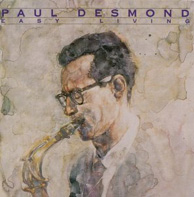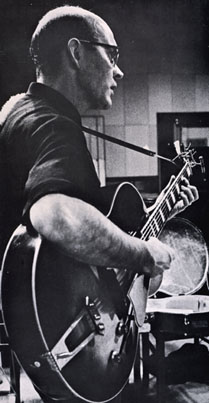

|
Soundclip:
|
| See Steve's Hand-Written Solo
Transcription |
|
Jim Hall's solo on: "That Old Feeling"(Fain-Brown) "I saw you last night and got that old feeling," and so  the song begins, but each time I revisit the playing of Jim Hall, I get a certain "old feeling" too.
That 'feeling' is simply one of respect and admiration. If it wasn't apparent before,
it certainly will be now, my favorite performances from Jim will always be his
work with saxophonist, Paul Desmond. "That Old Feeling" comes from Desmond's recording titled "EASY LIVING"(RCA), which was recorded in 1963. This particular session included Gene Wright on bass and Connie Kay on drums. the song begins, but each time I revisit the playing of Jim Hall, I get a certain "old feeling" too.
That 'feeling' is simply one of respect and admiration. If it wasn't apparent before,
it certainly will be now, my favorite performances from Jim will always be his
work with saxophonist, Paul Desmond. "That Old Feeling" comes from Desmond's recording titled "EASY LIVING"(RCA), which was recorded in 1963. This particular session included Gene Wright on bass and Connie Kay on drums.This particular transcription has been laying around in one of my old, old notebooks from college and I recently reviewed and could see and hear why I never felt it was ready to be shared. I used to believe that one had to be able to notate everything with 'total unchallengeable accuracy.' Of course, with some degree of maturity now, I know that this is not an absolute, and the notation of anything which was improvised could be interpreted and 'correctly' in any number of ways. Since the launching of the website and the debut of KHAN'S KORNER, I have continued to state that I simply try to write down what I thought the player was 'trying' to play. This more than trying to write exactly what was played. Improvising anywhere, but especially under recording studio conditions, is most difficult and pressure-filled and so, when one is in the flow of a performance, an error in the execution of complex idea can occur. This is not something, in my view, to be criticized. It is simply a reality. So, if something you see does not match, exactly, with what you hear, please understand what I was trying to do in the process of sharing the work of this wonderful musician, guitarist, Jim Hall. "That Old Feeling" has the 'fingerprints' of Jim Hall's harmonic wisdom everywhere as the A-A' standard is approached. I am saying that these are not the 'changes' you would see if you bought the sheet music version in your local music store. As it often was on these Desmond-Hall Quartet recordings, Jim's solo follows that of Paul Desmond. Here we are given the gift of a bountiful 3-chorus solo full of grace and nuance.  As with all Jim Hall solos, one signature is his determination to encorporate the development of ideas and motifs. In that regard, this solo is no different. Firstly, you can hear that Jim allows Paul Desmond's last phrase and notes to decay fully before he begins. This, to me, shows great respect and restraint. I don't think that it is ever a good idea to jump in right on top of someone else's improvisation. If one views music like this in units of 2 and 4-bar phrases, Jim begins by playing a phrase in bars 2-3 which lands on the rhythm of an 8th-note to a quarter. In bars 5, 7, 9, 10 and 11 this little idea is expanded to the figure of 8th-note, quarter note, 8th-note again! There's a wonderful little melodic/rhythmic idea which begins [A2] for the first 4 bars. Chorus [2] begins with some 3rds, but that little idea only lasts for 4 bars. The chordal passages in [A2] of this chorus have a certain rhythmic continuity to them. This sensibility returns in [A2] of Chorus [3] for the first 8 bars. As with all Jim Hall solos, one signature is his determination to encorporate the development of ideas and motifs. In that regard, this solo is no different. Firstly, you can hear that Jim allows Paul Desmond's last phrase and notes to decay fully before he begins. This, to me, shows great respect and restraint. I don't think that it is ever a good idea to jump in right on top of someone else's improvisation. If one views music like this in units of 2 and 4-bar phrases, Jim begins by playing a phrase in bars 2-3 which lands on the rhythm of an 8th-note to a quarter. In bars 5, 7, 9, 10 and 11 this little idea is expanded to the figure of 8th-note, quarter note, 8th-note again! There's a wonderful little melodic/rhythmic idea which begins [A2] for the first 4 bars. Chorus [2] begins with some 3rds, but that little idea only lasts for 4 bars. The chordal passages in [A2] of this chorus have a certain rhythmic continuity to them. This sensibility returns in [A2] of Chorus [3] for the first 8 bars.And, while we are speaking of 3rds, there's a little idea he toys with in bar 14 of [A] in Chorus [3] which is over a static F7 chord, and he's alluding to the whole-tone scale but when one attempts this on the guitar, those 3rds lay easily on our 'G' and 'B'-strings. This idea previously appeared in bars 22-23 of the "Poor Butterfly" solo which was recorded two weeks earlier. This, of course, makes perfect sense! As he begins Chorus [3], during the first 8 bars. he develops a small motif utilizing his own version of, what I used to refer to as 'drag picking' because the notes are descending in small groupings and one drags, or pulls the pick back against the strings. Of course, in today's parlance, this has become known as "sweep picking." The solo is also marked by some long lines which offer perfect examples of how, during those years, Jim was beginning to 'smooth out' his playing by eliminating unnecessary picked strokes, and trying to form a more legato approach to swinging on the guitar. Obviously, the influence of horn players is apparent! Again, it is this very notion from which many of your present favorite guitarists in this genre have benefited greatly. I have mentioned their names in previous analyses. Beautiful examples of this can be found in Chorus [1] [A] in bars: 13-16; [A2] in bars: 8-13; Chorus [2] [A] in bars: 8-10; [A2] in bars: 4-8; Chorus [3] [A2] in bars: 9-13. Another element which always gives a melodic flow to an improvisation is the approaching, or the anticipation of the next chord from the bar before its arrival. Examples of this can be found in Chorus [1] [A] in bars: 6-7, 14-15; [A2] in bars: 4-5, 11-12; Chorus [2] [A] in bars: 8-9, 10-11, 12-13; [A2] in bars: 4-5; Chorus [3] pick-up into bar 1; 4-5; 12-13; [A2] in bars: 10-11, and 11-12. Jim offers some nice chordal passages as well, and they begin to appear as letter [A] of Chorus [2] comes to an end in bar 16. Then at bar 9 of [A2] of that same chorus, he marks the changes nicely with very traditional voicings from this period and style of jazz guitar. From a rhythmic perspective, the rhythm he employs most frequently in this particular tempo is 8th-note, quarter-note, 8th-note beginning either on beat 1 or beat 3. During [A2] of Chorus [3], Hall closes out the solo with another chordal passage. As guitarists, you might want to check-out the voicing he employs in bar 8, which I have labeled as, D7(#9/#5). The notes, once fingered from your A-string across to the B-string, might appear to look like something akin to an Ab7(9/13) voicing. And of course, this would be a b5 sub for D7(alt.). However, you must finger both the C & F with your 2nd finger, and the Bb with your 3rd finger. Then, you must extend your 'pinky' to be able to add-in the high F. It will take some practice to get used to this voicing, but it will add a little something extra to your chordal arsenal. During the last four bars of this section, he uses a descending sequence of 'guide tone' voicings where it is easy to add the 13th or #9, depending upon what your root might be. It is a very nice way to finish and allow Paul Desmond's alto sax to return at a comfortable volume level for him. As it always it, it is truly a pleasure to present another Jim Hall solo from this wonderful period of his work. It is especially nice, because I happen to love this tune very much. If you are looking for another perspective on this particular standard, you might want to check out, the Roy Haynes version from his recent CD titled, "LOVE LETTERS"(Columbia) which features some great John Scofield. I have little doubt that John is very familiar with the Jim Hall version.
[Photo of Jim Hall by: Jutta Matthess from "IT'S NICE TO BE WITH YOU"(MPS) Germany, '69 ]
|